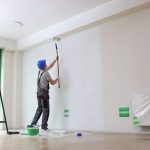How Often Should You Repaint Your Home’s Interior and Exterior?
A fresh coat of paint does more than enhance the aesthetic appeal of your home; it also serves as a protective barrier against wear, tear, and the elements. Homeowners often wonder about the ideal frequency for repainting both the interior and exterior of their houses. While the answer depends on several factors—from the quality of the previous paint job to the local climate—understanding these variables can help you maintain your property’s beauty and longevity.
The Interior: A Matter of Aesthetic and Health
For many homeowners, interior repainting is largely about keeping the environment attractive and up-to-date. Walls, ceilings, and trim endure everyday wear and tear. In high-traffic areas such as kitchens, hallways, and living rooms, the need for repainting might arise sooner than in less frequently used spaces. House painters in east Auckland suggest repainting only when required.
Typically, it’s recommended to repaint interior spaces every 5 to 7 years. This interval ensures that the colours remain vibrant and the surfaces are free from marks, stains, or signs of aging. However, several factors can influence this schedule:
Factors Influencing Interior Repainting Frequency
- Quality of Previous Paint Job:
Investing in high-quality paint and proper application techniques can extend the lifespan of your interior walls. Premium products tend to resist wear and fading better than budget alternatives, often allowing for longer intervals between repaints. - Exposure to Natural Light:
Rooms that receive an abundance of sunlight may fade faster due to UV exposure. If you notice that your walls are losing their lustre, it might be time for a refresh—even if it hasn’t been the standard 5 to 7 years. - Household Activity:
Families with young children, pets, or high foot traffic may require more frequent repainting. In such cases, marks and minor damages can accumulate quickly, prompting a need for regular touch-ups or a complete repaint. - Evolving Decor Trends:
Sometimes, the need for repainting is driven by changes in taste or design trends. As your personal style evolves, updating the colour scheme of your home can keep your living environment modern and fresh.
For most homeowners, a general guideline is to repaint interior spaces every 5 to 7 years. However, the actual frequency may vary depending on these influencing factors. Before you decide to repaint, inspect your walls for discolouration, peeling, or mould. Addressing these issues early not only improves the visual appeal but also contributes to a healthier indoor environment.
The Exterior: Shielding Your Home from the Elements
Exterior surfaces face a different set of challenges. They are in constant contact with weather conditions—rain, wind, sun, and even pollution. These factors cause the paint to deteriorate over time, so a strong, durable finish is crucial.
On average, it’s advisable to repaint the exterior of your home every 5 to 10 years. Again, this depends on a few key variables:
- Climate: Homes in harsh climates with extreme temperatures, high humidity, or heavy rainfall might require more frequent repainting. In contrast, houses in milder climates can often extend the life of their paint job.
- Surface Material: Different materials hold paint differently. Wood, for instance, is more susceptible to moisture and may need more regular attention compared to stucco or brick. Inspecting the specific surfaces can provide guidance on repainting schedules.
- Preparation and Application: Proper surface preparation—cleaning, priming, and patching—plays a crucial role in the longevity of an exterior paint job. Poor preparation can lead to premature peeling or cracking.
- Colour Choices: Darker colours absorb more heat, potentially causing the paint to degrade faster than lighter shades. This factor might necessitate a more frequent refresh, especially in sunny regions.
Regular inspections are key. Look for signs of peeling, chalking, or blistering, and consider the overall appearance. If the exterior starts to look tired, it’s not just a matter of style; deteriorating paint can leave your home vulnerable to water damage and other issues.
Practical Tips to Maximize Paint Longevity
While adhering to a regular repainting schedule is important, there are practical steps you can take to extend the life of your paint:
- Routine Cleaning: Dust, dirt, and grime can accumulate over time. Regular cleaning of both interior and exterior surfaces can help maintain a fresh look and prevent long-term damage.
- Touch-Ups: Instead of waiting for the entire surface to degrade, consider spot repairs and touch-ups as soon as you notice minor issues. This approach can delay the need for a complete repaint.
- Quality Materials: As mentioned, investing in high-quality paint and proper tools can make a significant difference. Not only will the finish be more vibrant, but it will also last longer, saving you time and money in the long run.
- Professional Advice: When in doubt, consult with a professional painter. Their expertise can help you assess the condition of your current paint job and determine the best time to refresh your home’s surfaces.
Aesthetic Appeal with Protection
The frequency of repainting your home’s interior and exterior hinges on a balance between maintaining an attractive living space and ensuring your home is well-protected from environmental factors. Regular repainting not only enhances curb appeal but also plays a critical role in preserving the structural integrity of your property.


 Previous Post
Previous Post
